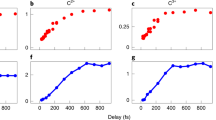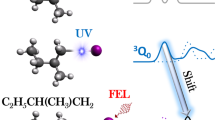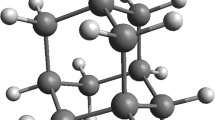Abstract
All properties of molecules—from binding and excitation energies to their geometry—are determined by the highly correlated initial-state wavefunction of the electrons and nuclei. Details of these correlations can be revealed by studying the break-up of these systems into their constituents. The fragmentation might be initiated by the absorption of a single photon1,2,3,4,5,6, by collision with a charged particle7,8 or by exposure to a strong laser pulse9,10: if the interaction causing the excitation is sufficiently understood, the fragmentation process can then be used as a tool to investigate the bound initial state11,12. The interaction and resulting fragment motions therefore pose formidable challenges to quantum theory13,14,15. Here we report the coincident measurement of the momenta of both nuclei and both electrons from the single-photon-induced fragmentation of the deuterium molecule. The results reveal that the correlated motion of the electrons is strongly dependent on the inter-nuclear separation in the molecular ground state at the instant of photon absorption.
This is a preview of subscription content, access via your institution
Access options
Subscribe to this journal
Receive 51 print issues and online access
$199.00 per year
only $3.90 per issue
Buy this article
- Purchase on Springer Link
- Instant access to full article PDF
Prices may be subject to local taxes which are calculated during checkout



Similar content being viewed by others
References
Kossmann, H., Schwarzkopf, O., Kämmerling, B. & Schmidt, V. Unexpected behavior of double photoionization in H2 . Phys. Rev. Lett. 63, 2040–2043 (1989)
Dujardin, G., Besnard, M. J., Hellner, L. & Malinovitch, Y. Double photoionization of H2: An experimental test of electronic-correlation models in molecules. Phys. Rev. Lett. 35, 5012–5019 (1987)
Reddish, T. J., Wightman, J. P., MacDonald, M. A. & Cvejanovic, S. Triple differential cross section measurements for double photoionization of D2 . Phys. Rev. Lett. 79, 2438–2441 (1997)
Wightman, J., Cvejanovic, S. & Reddish, T. J. (γ,2e) cross section measurements of D2 and He. J. Phys. B 31, 1753–1764 (1998)
Seccombe, D. P. et al. Photodouble ionization differential cross sections for D2 with various electron energy sharing conditions. J. Phys. B 35, 3767–3780 (2002)
Dörner, R. et al. Double photoionization of spatially aligned D2 . Phys. Rev. Lett. 81, 5776–5779 (1998)
Afaneh, F. et al. Must saddle point electrons always ride on the saddle? J. Phys. B. 35, L229–L235 (2002)
Wood, R. M., Edwards, A. K. & Steuer, M. F. Dissociative ionization of H2 and D2 produced by bombardment with fast He+ ions. Phys. Rev. A 4, 1433–1437 (1977)
Staudte, A. et al. Observation of a nearly isotropic, high-energy Coulomb explosion group in the fragmentation of D2 by short laser pulses. Phys. Rev. A. 65, 020703-1–020703-4 (2002)
Rottke, H. et al. Coincident fragment detection in strong field photoionization and dissociation of H2 . Phys. Rev. Lett. 89, 013001-1–013001-4 (2002)
Moshammer, R. et al. The dynamics of target ionization by fast highly charged projectiles. Nucl. Instr. Meth. Phys. Res. B 107, 62–66 (1996)
Levin, V. G., Neudatchin, V. G., Pavlitchankov, A. V. & Smirnov, Yu. F. A study of the electron correlations in the H2 molecule using the double photoionisation process (γ,2e). J. Phys. B 17, 1525–1536 (1984)
Rescigno, T. N., Baertschy, M., Isaacs, W. A. & McCurdy, C. W. Collisional breakup in a quantum system of three charged particles. Science 286, 2474–2479 (1999)
Weber, T. et al. Fully differential cross sections for photo-double-ionization of D2 . Phys. Rev. Lett. 92, 163001-1–163001-4 (2004)
Briggs, J. & Schmidt, V. Differential cross section for photo-double-ionization of the helium atom. J. Phys. B 33, R1–R48 (2000)
Dörner, R. et al. Photo-double-ionization of He: Fully differential and absolute electronic and ionic momentum distributions. Phys. Rev. A 57, 1074–1090 (1998)
Le Rouzo, H. Double photoionization of molecular hydrogen: A theoretical study including the nuclear dissociation. Phys. Rev. A 37, 1512–1523 (1988)
Dörner, R. et al. Cold target recoil ion momentum spectroscopy: a ‘momentum microscope’ to view atomic collision dynamics. Phys. Rep. 330, 95–192 (2000)
Ullrich, J. et al. Recoil-ion and electron momentum spectroscopy: reaction-microscopes. Rep. Prog. Phys. 66, 1463–1545 (2003)
Weber, T. et al. Correlated electron emission in multiphoton double ionization. Nature 405, 658–661 (2000)
Schulz, M. et al. Three-dimensional imaging or atomic four-body processes. Nature 422, 48–50 (2003)
Walter, M. & Briggs, J. S. Selection rules and isotope effects in the full fragmentation of the hydrogen molecule. Phys. Rev. Lett. 85, 1630–1633 (2000)
Walter, M. & Briggs, J. S. Photo-double ionization of molecular hydrogen. J. Phys. B 32, 2487–2501 (1999)
Weber, T. et al. Auger electron emission from fixed-in-space CO. Phys. Rev. Lett. 90, 153003-1–153003-4 (2003)
Díez Muiño, R., Rolles, D., de Abajo, F. J. G., Fadley, C. S. & Hove, M. A. V. Angular distribution of the electrons photoemitted from core levels of oriented diatomic molecules: multiple scattering theory in non-spherical potentials. J. Phys. B 35, L359–L365 (2002)
Feagin, J. M. A helium-like description of molecular hydrogen photo-double ionization. J. Phys. B 31, L729–L736 (1998)
Reddish, T. J. & Feagin, J. M. Photo double ionization of molecular deuterium. J. Phys. B 32, 2473–2486 (1999)
Joy, H. W. & Parr, R. G. A one-center wave function for the hydrogen molecule. J. Chem. Phys. 28, 448–453 (1958)
Kheifets, A. S. & Bray, I. Application of the CCC method to the calculation of helium-photoionization triply differential cross sections. J. Phys. B 31, L447–L453 (1998)
Hayes, E. F. Accurate single-center expansions using Slater type orbitals: hydrogen molecule. J. Chem. Phys. 46, 4004–4008 (1967)
Acknowledgements
We thank Roentdek GmbH (http://www.Roentdek.com) for support with detectors, and acknowledge helpful discussion with colleagues M. Walter, J. Briggs, J. Feagin, T. Reddish and V. Schmidt. This work was supported by the Deutsche Forschungs Gemeinschaft, the Bundesministerium für Bildung und Forschung, and the Chemical Sciences, Geosciences and Biosciences Division, Office of Basic Energy Sciences, Office of Science, US Department of Energy (DOE). T.W. thanks Graduiertenförderung des Landes Hessen, the Alexander von Humboldt Stiftung and the Herrmann Willkomm Stiftung for financial support.
Author information
Authors and Affiliations
Corresponding author
Ethics declarations
Competing interests
The authors declare that they have no competing financial interests.
Rights and permissions
About this article
Cite this article
Weber, T., Czasch, A., Jagutzki, O. et al. Complete photo-fragmentation of the deuterium molecule. Nature 431, 437–440 (2004). https://doi.org/10.1038/nature02839
Received:
Accepted:
Issue Date:
DOI: https://doi.org/10.1038/nature02839
This article is cited by
-
Step-by-step state-selective tracking of fragmentation dynamics of water dications by momentum imaging
Nature Communications (2022)
-
Imaging the square of the correlated two-electron wave function of a hydrogen molecule
Nature Communications (2017)
-
Plane Wave in the System of N Particles with Zero Angular Momentum
Few-Body Systems (2016)
-
Can electrons attract one another?
Science China Chemistry (2014)
-
Ultralong-range energy transfer by interatomic Coulombic decay in an extreme quantum system
Nature Physics (2010)
Comments
By submitting a comment you agree to abide by our Terms and Community Guidelines. If you find something abusive or that does not comply with our terms or guidelines please flag it as inappropriate.



